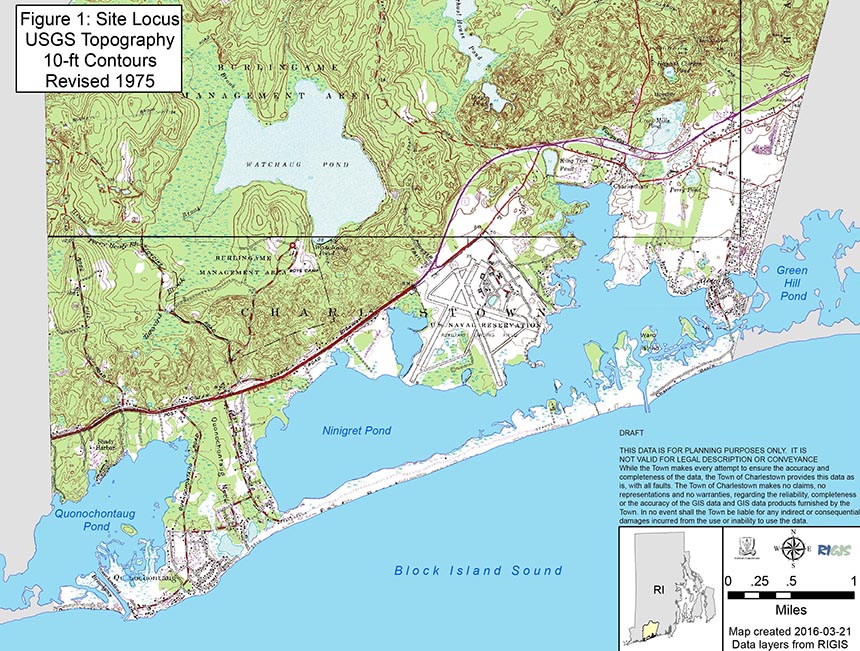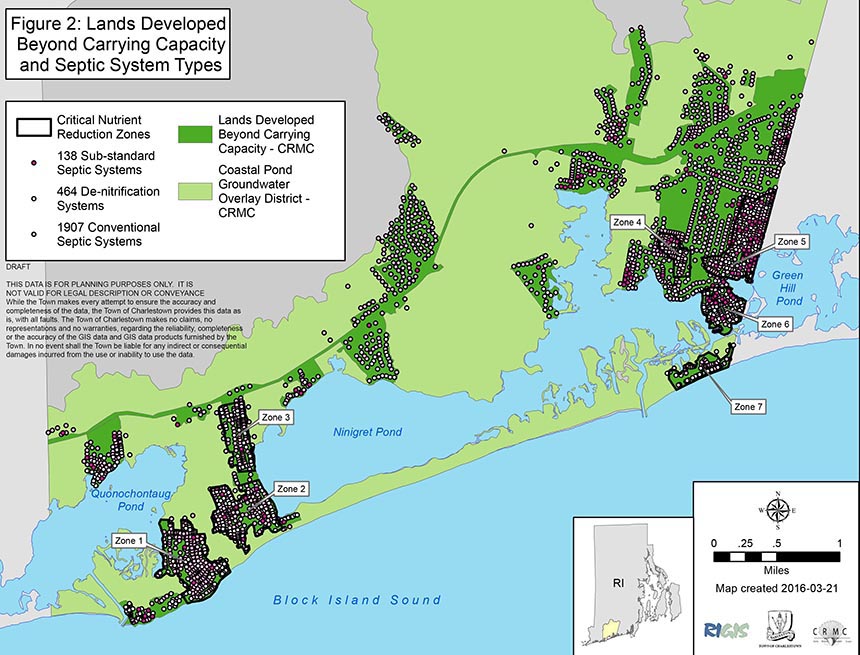By FRANK CARINI/ecoRI
News staff

Charlestown’s three coastal salt ponds are being negatively impacted by a high concentration of housing, especially eastern Ninigret Pond and Green Hill Pond.
People flock to live on and visit the coast here, but in the town’s most-densely developed area, excess nitrogen from all those coastal dwellings is threatening the health of three salt ponds that connect to Block Island Sound and are the foundation of the local tourism industry.
This salt ponds
watershed makes up 33 percent of the town but contains 63 percent of all
Charlestown dwellings. Dense development around the Ocean State’s coastal salt
ponds isn’t limited to Charlestown.
The salt pond region of
southern Rhode Island extends from Maschaug Pond in Westerly to Point Judith
Pond in Narragansett and forms the natural boundary between the Atlantic Ocean
and a shallow freshwater aquifer. This watershed is so built up that vital
ecosystems are under enormous pressure.
“A burgeoning population
and increasing competition among activities threatens to overwhelm the capacity
of the salt ponds to absorb wastes, provide shelter for boats and vessels,
attract residents and tourists and underpin premium real estate values,”
according to the Coastal Resources Management Council’s Salt Ponds Region Special Area Management Plan.
“Large areas of the salt ponds are poorly flushed, which makes them valuable as fish and shellfish nurseries, but, also particularly susceptible to eutrophication and bacterial contamination.”
“Large areas of the salt ponds are poorly flushed, which makes them valuable as fish and shellfish nurseries, but, also particularly susceptible to eutrophication and bacterial contamination.”
Studies and surveys by
the Environmental Protection Agency (EPA) and by state agencies across the
country have found that nonpoint source pollution, such as excess
fertilizers, herbicides, and insecticides, oil, grease, and toxic chemicals
from runoff, and bacteria and nutrients from faulty septic systems, causes the
most harm to rivers, streams, lakes, estuaries, coastal waters, and wetlands.
In Rhode Island’s salt
pond region, cesspools and failing and substandard septic systems are the
largest source of bacterial and nutrient contamination.
In Charlestown, work done by the University of Rhode Island's Cooperative Extension and Nonpoint Education for Municipal Officials has found that 80 percent of groundwater nitrate is from onsite wastewater treatment systems.
In Charlestown, work done by the University of Rhode Island's Cooperative Extension and Nonpoint Education for Municipal Officials has found that 80 percent of groundwater nitrate is from onsite wastewater treatment systems.
In the town’s coastal pond watershed sampling of private wells has found nitrogen concentrations that approach or exceed the EPA established maximum contaminant level of 10 milligrams per liter. The EPA action level is 5 mg/L. Charlestown relies exclusively on groundwater for drinking.
Besides contaminating
drinking-water wells, this nitrogen-enriched groundwater also eventually flows
into Charlestown’s three coastal salt ponds, where it causes eutrophication and increases the risk
of hypoxia.
Since 1994, Green Hill
Pond and eastern Ninigret Pond have been closed to shellfishing because of
“significantly deteriorated water quality.”
The total average annual
influx of nitrogen to Charlestown’s three coastal ponds is nearly 1.2 million
pounds, according to the Rhode Island Department of Environmental Management
(DEM). Here is the breakdown: Green Hill Pond, 46,903 pounds; Ninigret Pond,
44,794; Quonochontaug Pond, 24,579.
Matt Dowling, hired in
2008 as Charlestown’s first full-time onsite wastewater manager — only a
handful of Rhode Island municipalities have a such a position — recently told
ecoRI News that reducing nitrogen loading is a major priority from both a
public-health and environmental-protection perspective.
Charlestown began
addressing the problem in earnest four years before Dowling, an environmental
scientist, was hired.

In the town’s coastal
pond watershed sampling of private wells has found nitrogen concentrations that
approach or exceed EPA established maximum contaminant levels.
Filling in holes
In 2004, three years before a Rhode Island enacted a law to address a statewide problem, Charlestown officials took a bold step by requiring the elimination of all cesspools, which are merely holes in the ground that do nothing to treat human waste.
These 55-gallon or so concrete- or stone-lined pits with holes in which sewage is flushed offer no treatment for pathogens, harmful bacteria, and nutrients, most notably nitrogen.
In 2004, three years before a Rhode Island enacted a law to address a statewide problem, Charlestown officials took a bold step by requiring the elimination of all cesspools, which are merely holes in the ground that do nothing to treat human waste.
These 55-gallon or so concrete- or stone-lined pits with holes in which sewage is flushed offer no treatment for pathogens, harmful bacteria, and nutrients, most notably nitrogen.
Cesspools and failing
septic systems contaminate groundwater, the only source of drinking water in
Charlestown. Conventional septic systems, meanwhile, do little to address the
problem of nitrogen loading.
The town’s
forward-thinking ordinance that required all cesspools be removed and replaced
by 2009 was later modified. A zoned phase-out was implemented that mandated
cesspools to be replaced by June 2014. Mission nearly accomplished.
Of the nearly 1,000 cesspools
that once marked the local landscape, only 12 remain, according to Dowling.
The removal of the
remaining cesspools is being managed through the town’s municipal court or by
the Wastewater Management Commission’s waiver program that grants relief to
property owners with financial hardships.
Statewide, DEM
identified 1,084 cesspools subject to Rhode Island Cesspool Act of 2007 provisions
requiring the replacement of those within 200 feet of a coastal shoreline
feature, within 200 feet of a public drinking-water well, or within 200 feet of
a public drinking-water reservoir, according to an agency spokeswoman.
She recently told ecoRI
News that at last check 752 of those cesspools were replaced with a septic
system and 147 were removed from service because the property connected to a
sewer line, leaving 185 cesspools that haven’t yet come into compliance with
the law.


“It is worth noting that
these numbers are a snapshot,” she wrote in an e-mail. “There are sites working
through the permitting process all the time so it is likely that more cesspools
have been removed from service than are reported here.”
There are more than
3,000 onsite wastewater treatment systems in Charlestown’s salt ponds watershed
and nearly 84 percent are within a ‘Lands Developed Beyond Carrying Capacity’
area.
Nutrient overload
Conventional septic systems typically have final effluent nitrogen concentrations of 44 milligrams per liter. For a three-bedroom home, this amounts to a nitrogen discharge of some 21 pounds annually.
Conventional septic systems typically have final effluent nitrogen concentrations of 44 milligrams per liter. For a three-bedroom home, this amounts to a nitrogen discharge of some 21 pounds annually.
In Charlestown, there
are 3,008 onsite wastewater treatment systems in the salt ponds watershed. Of
those, nearly 84 percent, including 138 systems classified as unpermitted
and/or substandard and installed before 1968, are within a Coastal Resources
Management Council “Lands Developed Beyond Carrying Capacity” area, which
frequently means one residential or commercial unit per one-eighth to half an
acre.
In Charlestown, Dowling
noted that the housing density is 8-10 dwellings per acre, and each lot has a
septic system and well.
“Such intense
development was the major source of contamination to groundwater and the salt
ponds,” according to the Salt Ponds Region Special Area Management Plan.
“High nutrient loadings and contaminated runoff waters were resulting in a high incidence of polluted wells and increasing evidence of eutrophic conditions and bacterial contamination in adjoining salt pond waters.”
“High nutrient loadings and contaminated runoff waters were resulting in a high incidence of polluted wells and increasing evidence of eutrophic conditions and bacterial contamination in adjoining salt pond waters.”
Septic systems with
nitrogen-reducing technology, however, are designed to lower nitrogen
concentrations in wastewater by 50 percent. Dowling and the town are working
with property owners to install this technology in the coastal ponds watershed.
In the past eight years about 35 septic systems with this technology have been installed in Charlestown.
In the past eight years about 35 septic systems with this technology have been installed in Charlestown.
In 2016, Charlestown
received an EPA grant to, among
other things, help upgrade 15 substandard septic systems with nitrogen-reducing
technology. The chosen homeowners will be compensated 75 percent of the total
cost.
The $674,201 grant also is funding a quarterly effluent sampling program for up to 50 property owners with denitrification systems.
The $674,201 grant also is funding a quarterly effluent sampling program for up to 50 property owners with denitrification systems.
To make sure these
expensive systems — $25,000 on average — are working properly and not
underperforming, Dowling said data are needed to measure nitrogen output and to
adjust the systems to meet their optimal nitrogen-reducing capacity.
Barnstable County on Cape Cod is running a similar sampling program to help ensure a substantial decrease in nitrogen loading.
Barnstable County on Cape Cod is running a similar sampling program to help ensure a substantial decrease in nitrogen loading.
If the town were to be
sewered — an expensive proposition that would require an agreement with South
Kingstown — more property would be opened up to development, Dowling explained.
Less nitrogen would be discharged to groundwater and the coastal ponds, but
other development pressures would increase.
The four-year grant is
also being used to help the town’s voluntary Recommended Landscaper Process partner
with Save The Bay to install six demonstration rain gardens on public property,
and partner with the Salt Ponds Coalition to
establish two surface water sampling stations in Green Hill Pond to track
nutrient impacts.
Modeling has
demonstrated that fertilizer use contributes as much as 20 percent of the
groundwater nitrogen in densely areas where high-maintenance lawns are
clustered, according to Dowling.
Lawn chemicals aimed at
killing pests, insect or plant, also take a toll on the ponds' health. During a
recent visit to the area, two adjacent homes on Powaget Avenue had "Lawn
Chemicals Applied" signs in their front yards.